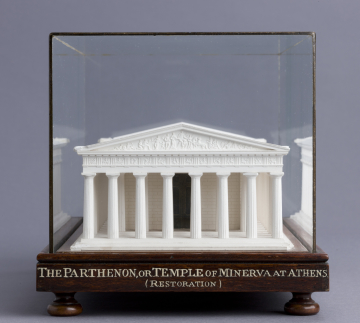Explore Collections


You are here:
CollectionsOnline
/
Model of the Parthenon, the largest temple on the Acropolis in Athens, 'restored', c.1800-1834.
Browse
François Fouquet (1787 - 1870), maker
Model of the Parthenon, the largest temple on the Acropolis in Athens, 'restored', c.1800-1834.
Plaster of Paris
Height: 17.5cm
Width: 18cm
Depth: 33.7cm
Width: 18cm
Depth: 33.7cm
Museum number: MR6
On display: Model Room (pre-booked tours only)
All spaces are in No. 13 Lincoln's Inn Fields unless identified as in No. 12, Soane's first house.
For tours https://www.soane.org/your-visit
Curatorial note
The Parthenon, on the Acropolis in Athens, is probably the most famous classical Greek temple. Built using the Doric order between 447 and 432 BC it was the work of the 5th century BC architects Ictinus and Kallicrates and replaced an earlier structure burnt down by the Persians in 480 BC when they sacked Athens. The Temple was dedicated to Athena Parthenos (or Athena the Virgin), the patron deity of the city. The renowned sculptor Phidias (fl. c.490-430 BC) supervised the sculptural decoration of the building, which adorned its pediments, frieze and metopes, now in the British Museum (the so-called 'Elgin marbles'. This model replicates the Doric architecture and sculptures on a minute scale and the white plaster gives a good impression of the brilliant white of the Pentelic marble used in the construction of the original building.
Fouquet based his reconstruction on an etched print showing the Parthenon by Le Roy (plate VII, Vol. II, in Les ruines des plus beaux monuments de la Grèce). Le Roy seems to have had accurate information regarding the sculptures showing the Battle of the Centaurs and Lapiths that decorate the metopes of the Temple and these have been followed in detail by Fouquet. However, he was less certain about the sculptural groups showing the Birth of Athena from the east pediment and does not reproduce the west façade in his book with its more poorly preserved pediment showing the Contest of Athena and Poseidon. In the model, Fouquet uses Le Roys’s conventionalised image of the east pediment sculpture and where the west pediment is not shown in the book, Fouquet just replicates the miniature relief he used for the east façade.
Fouquet based his reconstruction on an etched print showing the Parthenon by Le Roy (plate VII, Vol. II, in Les ruines des plus beaux monuments de la Grèce). Le Roy seems to have had accurate information regarding the sculptures showing the Battle of the Centaurs and Lapiths that decorate the metopes of the Temple and these have been followed in detail by Fouquet. However, he was less certain about the sculptural groups showing the Birth of Athena from the east pediment and does not reproduce the west façade in his book with its more poorly preserved pediment showing the Contest of Athena and Poseidon. In the model, Fouquet uses Le Roys’s conventionalised image of the east pediment sculpture and where the west pediment is not shown in the book, Fouquet just replicates the miniature relief he used for the east façade.
Sir John Soane purchased the twenty models by François Fouquet in 1834 from the architect Edward Cresy (1792-1858) who, from 1829 to 1835, worked in Paris. Soane paid Cresy the substantial sum of £100 (£10,136.78 in today’s money). It is likely that Cresy purchased the models directly from Fouquet et Fils.
Exhibition history
Order: Myth, Meaning and Beauty in Architecture, Sir John Soane's Museum, London, 16 October 2009 - 30 January 2010; Reading Museum, 22 January - 27 March 2011
Wonders of the Ancient World: François Fouquet's Model Masterpieces, Sir John Soane's Museum, London, 15 July - 22 November 2011
Wonders of the Ancient World: François Fouquet's Model Masterpieces, Sir John Soane's Museum, London, 15 July - 22 November 2011
Soane collections online is being continually updated. If you wish to find out more or if you have any further information about this object please contact us: worksofart@soane.org.uk





